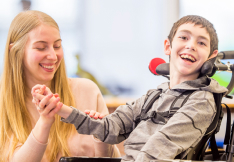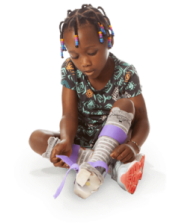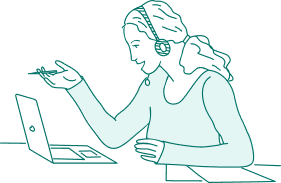What is the Gross Motor Function Classification System (GMFCS)?
 The Gross Motor Function Classification System (GMFCS) is a standardized tool used to describe the movement abilities of children with cerebral palsy (CP).
The Gross Motor Function Classification System (GMFCS) is a standardized tool used to describe the movement abilities of children with cerebral palsy (CP).
Pediatric care providers often use the GMFCS as part of early cerebral palsy evaluations. It’s often used alongside other CP classification tools, like the Manual Ability Classification System (MACS) and the Communication Function Classification System (CFCS).
GMFCS levels help classify children with cerebral palsy based on their current abilities, limitations, and typical use of assistive technology. Level I reflects the most independence, while Level V involves the greatest motor challenges and support needs.
Understanding your child’s GMFCS level can help clarify how cerebral palsy affects their mobility and daily life. Unfortunately, the more support a child needs, the more likely it is that families will face a lifetime of unexpected care costs.
When CP is caused by medical negligence, families may qualify for compensation to ease these financial burdens and hold negligent health care providers accountable.
Cerebral Palsy Guide works with top CP lawyers who can help families in all 50 states. Together, they’ve recovered over $1 billion for preventable birth injuries.
Get a free case review now to see if you may qualify for financial support to help cover the costs of your child’s lifelong care.
How GMFCS levels support care planning and communication
The GMFCS helps families, doctors, and therapists better understand how cerebral palsy affects a child’s self-initiated movement. It also plays an important role in setting goals, coordinating care, and planning for the future.
GMFCS levels can help by:
- Clarifying current mobility and equipment use
- Guiding cerebral palsy treatment and therapy planning
- Improving communication across care teams
- Informing research and clinical practice
- Planning for future support and services
- Setting realistic goals and expectations
In birth injury cases involving medical negligence, this classification may support legal action. It helps document long-term mobility challenges, care needs, and overall impact — key factors when building a cerebral palsy lawsuit.
What does each Gross Motor Function Classification System level mean?
The Gross Motor Function Classification System groups children into five levels based on how they move on their own, including sitting, walking, and using mobility aids.
The chart below shows how each GMFCS level relates to a child’s movement, independence, and typical equipment use.
| Level I | Able to walk without limitations; by age two, they can sit independently, and by age six, they can navigate curbs and stairs without railings. |
| Level II | Can walk with some limitations; might use handheld mobility devices or wheelchairs for longer distances. |
| Level III | Primarily walks with handheld mobility devices indoors but uses wheelchairs for community travel and longer distances. |
| Level IV | Limited self-mobility; primarily uses manual or powered wheelchairs, with possible short-distance walking with assistance. |
| Level V | Severe movement limitations; requires power wheelchair for mobility and complete assistance for most activities. |
Each Gross Motor Function Classification System level also varies by age groups, since motor skills can change as children grow. Learn what each GMFCS level means below.
Level I: Moves without limitations
Children at Level I walk without the need for support but may have slight issues with speed, balance, or coordination, especially during more advanced physical activities.
- 0–2 years: May crawl and walk by around 18 months
- 2–4 years: Can sit, move, and walk without assistive devices
- 6–12 years: Can walk, run, jump, and climb stairs but may have minor coordination or speed limitations
Children at this level are generally mobile and independent, with few noticeable movement challenges.
Level II: Moves with some limitations
Children at Level II walk independently in most settings but may struggle with uneven surfaces, long distances, or advanced motor tasks like running and jumping.
- 0–2 years: May sit with support and begin crawling or sliding
- 2–4 years: Can crawl, pull to stand, and walk using hand-held mobility aids like canes or crutches
- 6–12 years: Can walk on their own but may need help with balance, stairs, or navigating crowded areas
Children at this level move without help but may face limits during more complex or demanding physical activities.
Level III: Uses a mobility device
Children at Level III require assistive devices to walk and may use a powered or manual wheelchair for longer distances. They can often climb stairs with help or a railing.
- 0–2 years: May roll or slide but need support to sit
- 2–4 years: Can crawl or pull to stand and walk short distances with help or a hand-held mobility device
- 6–12 years: Typically walk with a mobility aid and may use a wheelchair for school or community activities
Children at higher GMFCS levels often rely on wheeled mobility devices to participate in daily activities.
Level IV: Limited self-mobility
Children at Level IV have limited ability to move on their own and rely on powered mobility or physical support. Walking is minimal, even with assistive devices.
- 0–2 years: May roll but need help to sit up
- 2–4 years: Can roll or crawl short distances but cannot stand without full assistance
- 6–12 years: Use powered wheelchairs for mobility and may participate in transfers or assisted standing
Children at this level rely heavily on parents and caregivers, as well as assistive mobility devices for movement and daily participation.
Level V: Needs full support for mobility and daily activities
Children at Level V have the most severe movement limitations. They cannot sit, stand, or walk on their own and require full physical assistance and support for daily tasks.
- 0–2 years: Have limited voluntary movement and need help to support the head and trunk
- 2–4 years: Extremely limited in independent movement but may use technology for powered mobility
- 6–12 years: Require full-time assistance and use specialized equipment for positioning and transportation
Children at this level need full support throughout the day, but can benefit greatly from individualized care and adaptive technology.
If you have questions about what GMFCS level may apply to your child, our registered nurses are here to help.
Connect with one of our registered nurses — for free.
Can the GMFCS help predict future mobility?
The Gross Motor Function Classification System (GMFCS) is not a tool for tracking progress, but it can help cerebral palsy doctors and specialists estimate a child’s future mobility based on their current level of motor function.
The Gross Motor Function Classification System classifies how a child typically moves and what equipment they use at different ages. The GMFCS classifies children based on their typical functional abilities, not their best performance.
Motor impairments can vary widely in CP, which is why tools like the Gross Motor Function Classification System are useful.
To better understand long-term outcomes, the GMFCS is often used alongside the Motor Development Curves (formerly known as the Motor Growth Curves), which chart how gross motor skills typically develop over time in children with cerebral palsy.
Together, these tools can help clinicians and care teams plan realistic goals, anticipate future support needs, and guide families through each stage of development.
If you suspect your child’s CP was caused by a mistake during childbirth, we may be able to help you seek money to give your child the best quality of life.
Get a free legal consultation right now — there’s no cost or obligation.
How GMFCS levels help plan for equipment needs
A child’s Gross Motor Function Classification System level can help care teams understand what types of assistive technology or mobility equipment they may already use — or may need in the future.
The right equipment can improve safety, support independence, and enhance daily function.
- Adaptive equipment: Tools that support specific functions, such as communication aids or adaptive utensils
- Braces (orthotics): Support the legs and feet to improve balance, posture, and mobility
- Standers: Help children bear weight safely, strengthen leg muscles, and support upright positioning
- Wheelchairs: Provide mobility for children with limited or no walking ability; may be manual or powered, depending on the level of need
GMFCS levels can guide decisions about when to introduce certain equipment and how to adapt support as a child grows.
Unfortunately, many of these items can be expensive and may not be fully covered by insurance. For families affected by preventable birth injuries, cerebral palsy financial support may be available through a cerebral palsy lawsuit.
Get cerebral palsy legal help
Caring for a child with cerebral palsy often means navigating complex needs, from mobility challenges to expensive equipment and long-term care planning. These costs can add up quickly and catch families off guard.
If you believe a mistake during labor or delivery may have caused your child’s condition, we may be able to help.
Cerebral Palsy Guide works with top birth injury lawyers who can help families in all 50 states. Our legal partners have recovered over $1 billion for families affected by preventable birth injuries, including CP.
Talking to an experienced lawyer can help you understand your rights and figure out what to do next.
Call our trained patient advocates at (855) 220-1101 or get a free case review right now to find out if we can help.



